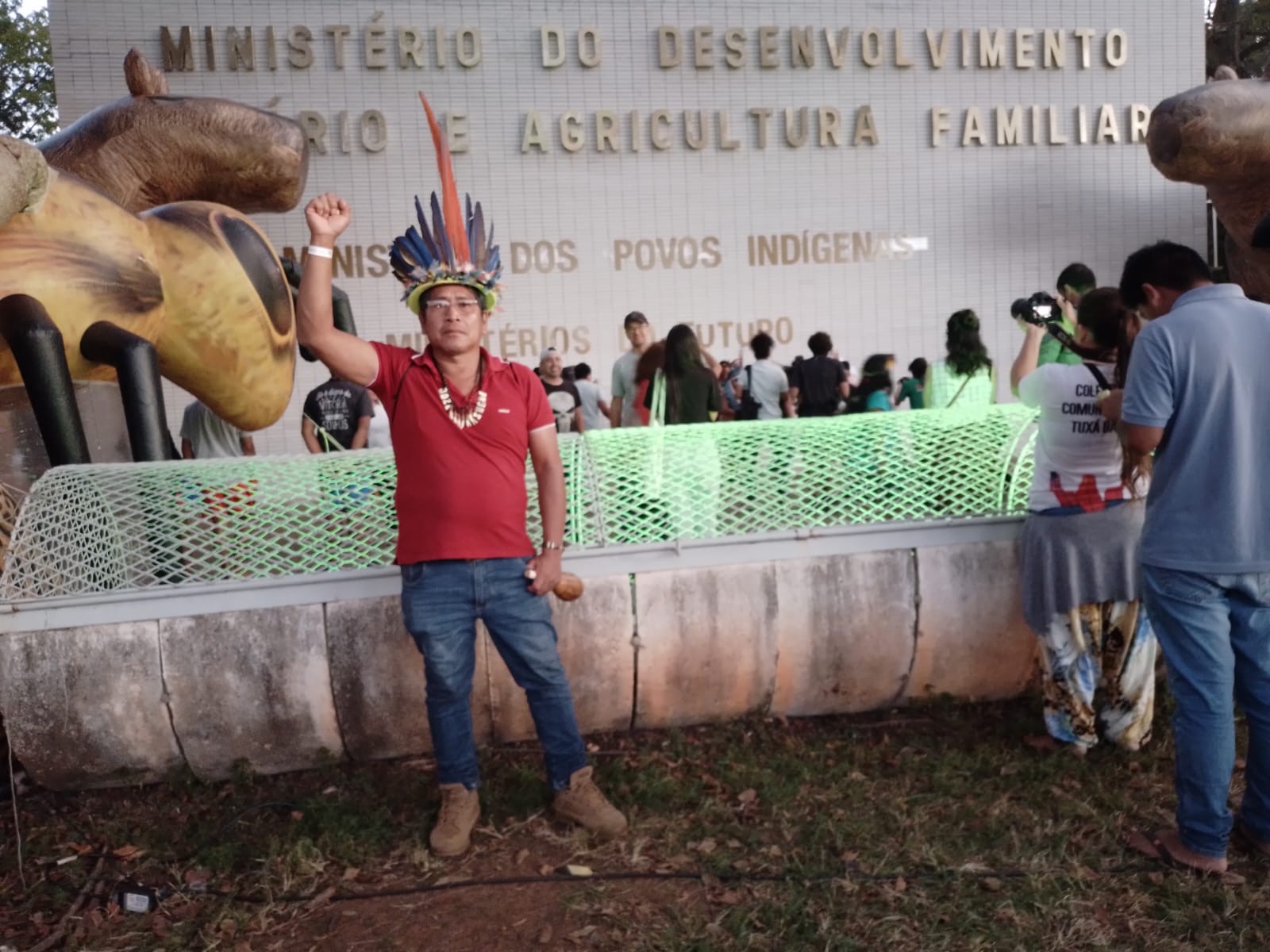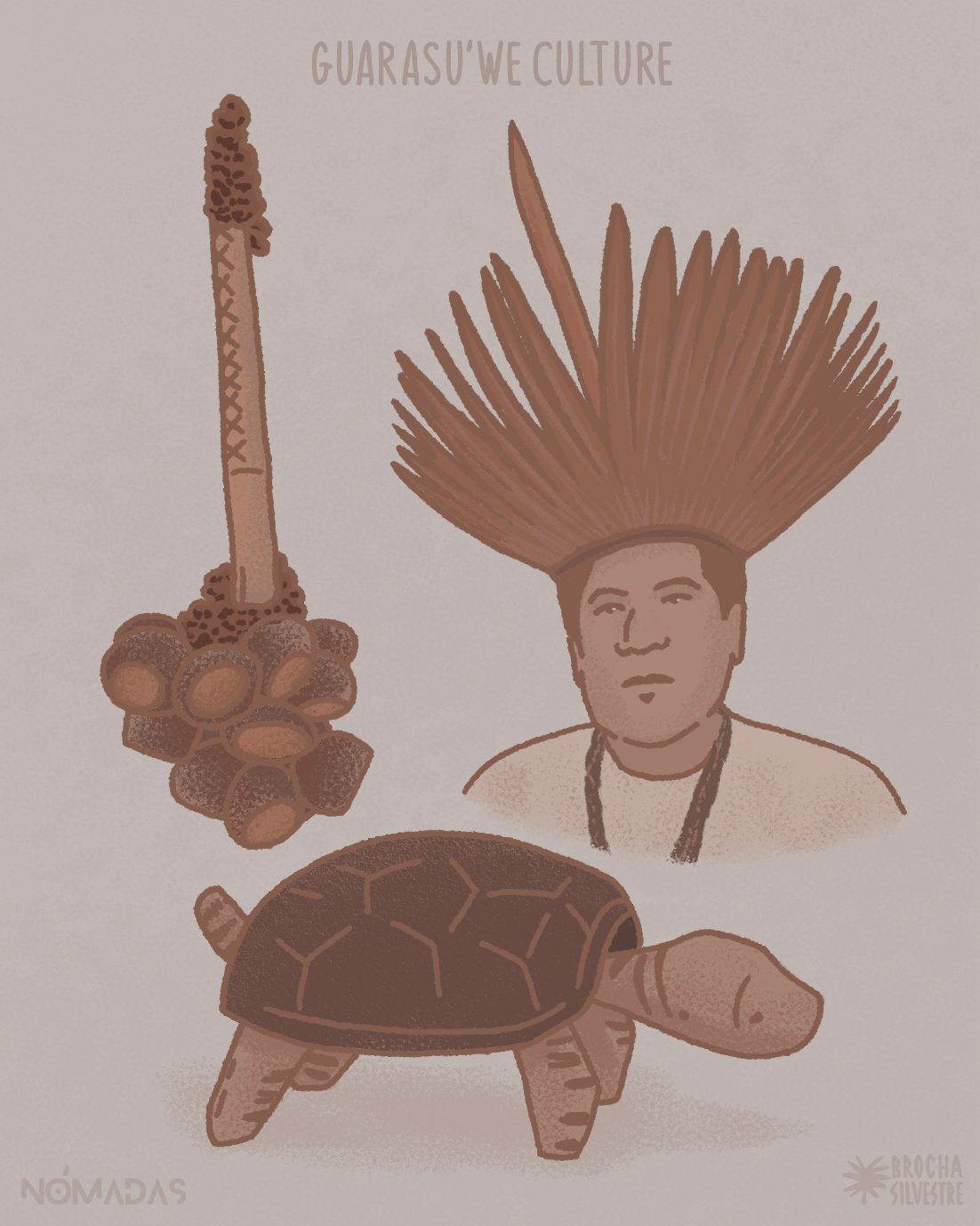TRIBES


TRIBES
April 16th, 2024
Like a broken omen, the Guarasu’we people resist the extinction announced in the 60s. Today, members of this great family from both Bolivia and Brazil, a people without borders, take the reins of their history, permanently leading a peaceful struggle to recover their ancestral territory, conquer their rights, honor the legacy of their ancestors and not let their tongue die in silence.

Lisa Mirella Corti
Journalist
This story is produced and published with financial support from the Google News Initiative News Equity Fund.

Illustration of the myth Guarasu’we: The Birth of Jaguars. Credit: Brocha Silvestre.
– “My language, I’m learning it again,” Rosa María Guarasu’we says with determination, on the podium where they are listening to her, because she, like her entire family, will never remain silent again: “Indigenous peoples are like a seed that It springs up in a burnt field: it is born and comes to life.”
The meeting of indigenous representatives at the XXIII General Assembly of the Indigenous Missionary Council (CIMI) in Brazil, 2019, is not the first lecture, nor was it the last for Rosa, a leader and activist of the Guarasu’we people who fights for the recovery of their ancestral territory.
On the other side of the Iténez River (Guaporé in Portuguese), Amelia Pereira—a not-too-distant relative of Rosa María—also has a very clear mission: she has been working for years on a thousand-piece puzzle, joining one day at a time and little by little, the alphabet of the Guarasugwe language. A language that her mother Carmen, her aunt Tarcila and her grandfather Juan only vaguely remember. She considers herself a language learner, she is learning, investigating, recovering the pieces so that she, like all the children at the only school in her Picaflor community, can have that puzzle in their memory for their entire lives.

Amelia Pereira, during the filming of the short film Picaflor. Credit: Javier Badani.
A language can die, and with it a vital piece in the puzzle of a culture disappears. That is why both Rosa María, with her firm conviction from Brazil, as an indigenous representative of her people in various meetings, protests and struggles; and Amelia Pereira, on the Bolivian side, make daily and, at the same time, titanic efforts to recover their language. They and their generation are the voices in the rebirth of their culture.
Like a broken omen, the Guarasu’we indigenous people—also known as Guarasugwe—have defied the reality of their near-extinction past, which in the 1960s Jürgen Riester, a German anthropologist, recounted in his book: Guarasu’we, Chronicles of the last days; where he regretted that only 60 people remained. Many things happened after this book that narrated a reality that, although crude, was a denunciation on the State’s neglect of the historical rights of the Guarasu’we. Its history was stained by blood, when in 1968, Captain Miguel — also known as Terékewé — leader of the Guarasu’we people was murdered by order of farmers in the Riozinho area, on the Brazil-Bolivia border. This tragedy did not end there, added to the advance in the 70s of land grabbing in Brazil, the Guarasu’we were expelled from their ancestral territory, and in 2023, they continue fighting to recover their land, their home and that of their ancestors, to become autonomous again, as they always were.
Riester was not wrong when he predicted extinction either, the constant threats now became heavier, and more constant. Without the resistance and continuous effort of the Guarasu’we family in Bolivia and Brazil—which now number more than 600 people—their culture would have been buried in oblivion.
This fear that it would be forgotten, that the culture could not be recovered, was what led Riester to Campo Grande—as the territory he visited in the 1960s was called—to immortalize, in writing, the material culture and spiritual of the Guarasu’we. Through long evenings and conversations with the locals, under the stars and in front of their houses enjoying the freshness of the tropical nights, Riester was able to record in his book 78 stories that allowed him to penetrate the world of Guarasu’we beliefs and myths. He thanks Tesere, his main narrator, whom he describes as having a calm and meditative nature, whose gift for recounting so vividly and expressing his thoughts in words managed to transmit his stories in writing.

Myth of the origin of jaguars, immortalized in Jürgen Riester’s book: Guarasu’we, Chronicles of the Last Days
On August 24, 2023, the Guarasu’we alphabet was approved in Bolivia, a momentous step for the recovery of its language and culture. All of this is the result of the technical and investigative work not only of Amelia but of the entire family unit, authorities and institutions that support this process. She knows that this fight for the memory of her people has not been and will not be easy; she remembers with nostalgia the awakening of conscience that the authorities, locals and leaders of his people had to experience for their territory to be recognized in Bolivia, to defend and consolidate that fundamental and historical right that belongs to them. Going from a group destined for “extinction” to organizing collectively to obtain representation at the community, municipal, departmental and even national level. Today, the Guarasu’we language and culture is recognized as one of the 36 official languages of the Bolivian Political Constitution, and in 2007 they obtained the title of their claimed Indigenous Indigenous Territory (TIOC). But for the Guarasu’we in Brazil, this fundamental right remains a pending task.
The indigenous people and their leaders in Brazil await the agrarian regularization of their ancestral territory to guarantee access to rights such as health, education, security and, above all, the recovery of their home, the land where they were born and are buried their ancestors. “Our sacred territory is where Miguel —Terékewé— Frei is buried, our sacred land for which we are fighting. They will always return to where our sacred land YACARERUPA is” – says Jose Frei, current captain of the Guarasu’we people and one of the authorities leading this collective fight.

Jose Frei, captain Guarasu’we in Brazil. Credit: Courtesy of Jose Frei.
And for more than 10 years they have been demanding, through all possible channels, the advancement of the demarcation of their Guarasu’we Indigenous Territory from the National Indian Foundation (FUNAI), the body of the Brazilian Government that establishes and develops policies related to indigenous peoples. But while they take a step forward, the obstacles from other interests in these lands not only delay, but also endanger the memory and future of indigenous communities throughout Brazil. Despite the national indigenous mobilizations and protests—in which Rosa María, Jose Frei and other members of the Guarasu’we people also participated—in May 2023, the controversial Bill 490/2007 was approved in the Chamber of Deputies in Brazil, a threat to indigenous demarcations, since it argues that the indigenous peoples of Brazil can only claim lands where they already were on October 5, 1988, the year the Constitution was promulgated. This for the Guarasu’we, and for all indigenous peoples that existed prior to the State, represents a violation of their historical rights of autonomy.
– Guarasu’we has a very long history, we have been resistant for 500 years, we are there resisting, we were almost exterminated like others. Indigenous people without territories, we are fighting together with other peoples for the territory… territories that were taken by ranchers, during the era of the syringa, of colonization when they wanted to exterminate all the peoples… we are resisting to this day, we are fighting for our rights, whether Bolivian or Brazilian, for our cultures, for our customs—says Jose Frei from his home in Pimenteiras de Oeste (Brazil), where he is constantly working for the dignity and memory of his family.

Illustration of Guarasu’we culture and Captain Jose Frei. Credit: Brocha Silvestre.
During Riester’s visit to the Guarasu’we people in the 1960s, he described with fascination how beautiful the crafts they made were, both their feather work and their necklaces, and with sadness he narrated in his writings that they no longer existed. He even felt that within a short time none of the artistic manifestations would be found. Today, in Brazil, there are Guarasugwe artisans who work, live and carry with them the cultural wealth and wisdom that their ancestors have given them. Whether through the sale of indigenous handcrafted instruments made of wood, crafts carved from fibers, or proudly using the meticulous work of their feather or woven headdresses with natural fibers during their meetings and representation spaces.
This chronicle of their decline was transformed into art with the new Guarasu’we generation in Bolivia, when the NGO founded by Riester: Apoyo Para el Campesino-Indígena del Oriente Boliviano (APCOB) – Support for the peasant-indigenous of the Bolivian East in English-, decided to work on an exhibition titled: “THE GUARASUG’WE : chronicle of his last days” in conjunction with the Picaflor community, with Amelia and authorities, based on the study of cultural and spiritual recovery that Riester did in his book of the same name. A catalytic work that sought to revalue, together with the Guarasu’we community, its past, its language and its own identity.
The parents, uncles, ancestors of Rosa María, Amelia, Jose and other members of the community have gone through historical stages of rejection, discrimination and shame where it was forbidden to speak their own language. A people forced to live hidden. Today, the descendants navigate with pride and determination through various places in the world, in Bolivia, Brazil, the United States and other places, carrying with them the memory of their language, their struggles, and their dreams. In the hope of recovering the territory that was always theirs.
Te contamos desde el interior de los escenarios de la realidad, iluminados por el faro de la agenda propia, el texto bien labrado y la riqueza poética del audiovisual y de la narrativa sonora, combinaciones perfectas para sentir el corazón del medioambiente y de los anónimos del Planeta.
